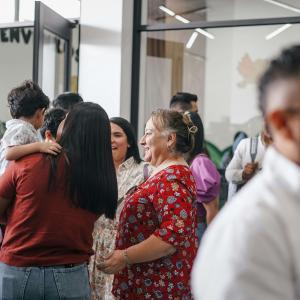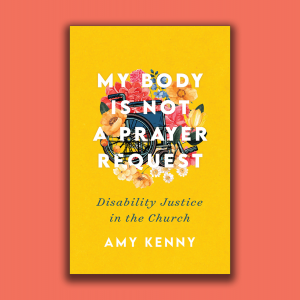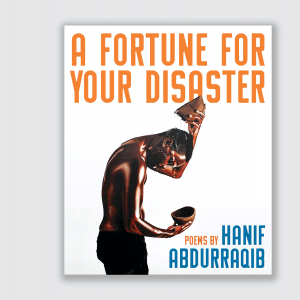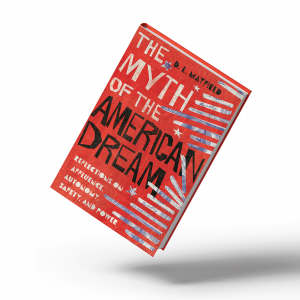
Posts By This Author
Leaving the Comfort Zone for ‘The Beautiful Something Else’
Ash Van Otterloo’s novel reminded me, an agnostic person, of the reign of God.
SPARROW HAS EVERYTHING under control. They know which clothes their mom likes them to wear, what kinds of grades reflect well on the family, and what topics to never ever talk about with their mother. But one day the formula collapses and Sparrow’s mother gets in a car crash. Now they must live with a relative they have never met and know nothing about. Used to a life of moving around due to their mother’s struggles with addiction, Sparrow thinks they have the perfect formula for how to blend in at their new school, but soon new friends, a magical creature, and a series of personal revelations take the middle schooler out of their comfort zone to somewhere much more beautiful.
Ash Van Otterloo’s The Beautiful Something Else follows the journey of a preteen living in the South. Sparrow, who is unknowingly nonbinary (at least at the beginning of the novel), has long played the role of an adult. Because their emotionally unstable mom has surrounded Sparrow with so many carefully constructed rules, the young protagonist hasn’t been able to find out who they really are — gender identity included. When Sparrow is forced to move in with their Aunt Mags (their closest relative), they are suddenly living in the one place their mother never wanted them to go: their mother’s childhood home in Tennessee. But Aunt Mags has reclaimed the space, renaming it Rainbow House. The property, with its many trailers and main house, is a haven for mostly queer families and local college students.
As an agnostic person, I don’t often reach for religious language, but Rainbow House reminded me of the reign of God, a collective utopia with no more suffering. Led by a loving and welcoming queer community, Rainbow House is a place where people farm the land, protect wildlife, host community gatherings and festivals, and practice radical forgiveness and generosity.
The Church Can Offer Trans Refuge From Bad Theology and Bad Legislation
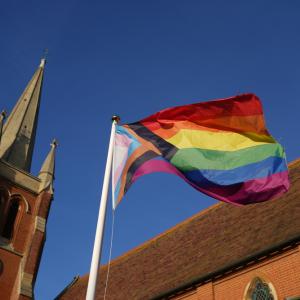
PA via Reuters A rainbow flag, a symbol of lesbian, gay, bisexual, transgender, and queer (LGBT) pride and LGBT social movements, flies at St John the Baptist church in Felixstowe, Suffolk, after the use of prayers of blessing for same-sex couples in Church of England services were approved by the House of Bishops. Picture date: Sunday December 17, 2023.
On April 16, 2025, the Supreme Court of the United Kingdom passed a ruling that the legal definition of a woman excludes transgender women in some cases. This came after the campaign group For Women Scotland fought to oppose sex-based protections for anyone not assigned female at birth. The group’s agenda had focused on the Scottish government’s interpretation of The Equality Act of 2010, which provides protections against discrimination. This ruling does not prevent trans people’s protection from discrimination as trans people, but it does reinforce the idea of a strict binary for gender.
5 Things Your Religious Community Can Do to Support Trans People

An American flag and a pride flag wave from a demonstrator's pole during a queer and transgender youth rally near the U.S. Capitol in Washington, D.C. on March 31, 2023, calling for autonomy following recent legislation and threats of violence directed towards transgender people. Credit: Reuters/Bryan Olin Dozier/NurPhoto.
Progressive churches or worship communities often present as accepting places — displaying LGBTQ+ flags or signs on their property or preaching messages that emphasize accepting and affirming LGBTQ+ people. Those are good places to start. But as the U.S. government escalates its discrimination against trans people, it is also necessary that religious communities escalate their support of the trans community. For communities that want to stand in solidarity with trans people, here are five additional action steps that you and your religious community can take.
I’m Agnostic. Here’s Why I Went Back to Church
Even in the depths of high-control religion, there were moments of being fed and cared for that I did not know I missed until I did.
The Quiet Liturgy of Fertility Treatment
When my husband and I started fertility treatment, we intentionally stopped going to church. Due to various traumatic religious experiences, we had been floating for over a year and we remained undecided on whether belonging to any religious organization would be part of our future. Then we went to a church service on Father’s Day weekend. Belting pop songs about the joy and goodness of God was already too much. But then they asked all fathers to stand and it broke us. Around this time, we alerted a small group of people that we were beginning fertility treatment and taking a break from church service.
Taking up a Theology of a Disabled God
Amy Kenny’s 'My Body Is Not a Prayer Request' — part memoir and part disability justice hermeneutic — is a challenge the church desperately needs.
SOME CHURCHES HAVE fought to be exempted from the Americans with Disabilities Act, have interpreted scripture in ways that cause violence against disabled people, and are often rife with ableist microaggressions unique to religious communities. Amy Kenny’s My Body Is Not a Prayer Request—part memoir and part disability justice hermeneutic—is a book the church desperately needs.
Kenny encounters strangers, many of them Christians, who comment on her body. They describe their ableist version of heaven, pray over her without consent (she refers to these people as “prayerful perpetrators”), ask for personal medical information, and give pitying glances. “I wish I was whole in their minds,” writes Kenny, “enough to exist without needing a prayerful remedy to cast out my ‘demons,’ a full human who has something to offer other than a miraculous narrative.”
Accuracy and Ampersands
A review of ‘A Fortune for Your Disaster,’ by Hanif Abdurraqib.
HERE WE LEARN from the ghost of Marvin Gaye, question the ethics of Nikola Tesla, examine the character of God, and drift in lament and wonder.
In these poems by Hanif Abdurraqib, violence appears in different forms. In some lines, it is a fistfight between teenagers in a schoolyard, in others the anti-Blackness of a suburb or the music industry: “[T]he mailman still hands me bills like I should feel lucky to have my name on anything in this town,” Abdurraqib writes.
Thirteen of the 51 poems are titled after a criticism he heard from a white woman at a poetry reading in 2016: “How can black people write about flowers at a time like this?”
D.L. Mayfield Questions the Myth of the American Dream
A review of “The Myth of the American Dream: Reflections on Affluence, Autonomy, Safety, and Power,” by D.L. Mayfield.
IN HER LATEST book, writer D.L. Mayfield welcomes readers on a journey of seeing. This essay collection weaves an exploration of the desires embedded in the American Dream with stories of Mayfield’s own social justice conversion and portraits of her Portland neighborhood.
These narratives of how colonialism, capitalism, racism, and consumerism store themselves in privileged American hearts invite self-reflection. Mayfield challenges the American Dream’s toxic individualism, dividing the book into four themes: affluence, autonomy, safety, and power. “We do not care that people will suffer and die,” she writes, “due to our own desire for safety.”
Mayfield reflects on her own awakening and exposure to xenophobic faith communities, where she began to have “serious problems reconciling the Suffering Servant with a conservative religious agenda.” The text also walks her readers through the gentrification of her neighborhood and how her community is affected by travel bans, the U.S. education system, and other aspects of local and national politics.
Faith Tides
A poem
I am Peter at Gethsemane
where I wake to oak
branches suspended,
spinning like hair in water.
Flora’s night
blanched, a prophet’s
chanting, every caesura’s
quiet steeping, transfiguring
grief to alms.

